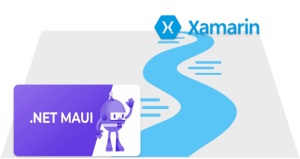
In the ever-evolving application development landscape, the transition from Xamarin to .NET Multi-platform App UI (.NET MAUI) marks a significant milestone. This movement is not just a leap towards advanced technology but a testament to Microsoft’s vision of unifying and enhancing the cross-platform app development experience. Through this blog, we aim to encapsulate the essence of our detailed journey explored in the comprehensive whitepaper, inviting you to delve into the transformation that .NET MAUI brings to the fore.
The Evolutionary Path from Xamarin to .NET MAUI
Our journey begins with understanding Microsoft’s strategic decision to retire Xamarin in favor of .NET MAUI. This pivotal shift is rooted in the desire to streamline the development process, incorporating a more integrated approach that caters to modern app development needs. Xamarin set the stage for cross-platform development, and .NET MAUI is poised to elevate this with improved performance, a simplified project structure, and a modern adaptive UI toolkit. The end of support for Xamarin is not just a sunset but a dawn that welcomes a more cohesive and robust framework in .NET MAUI.
Why .NET MAUI?
.NET MAUI stands as the beacon of modern app development, offering a unified codebase for mobile, desktop, and beyond. The framework simplifies project management and boosts developer productivity with a single-project structure spanning Android, iOS, macOS, and Windows. The introduction of adaptive layouts and controls ensures that applications are responsive and consistent across devices, enhancing the user experience. Moreover, .NET MAUI’s performance is a leap forward, with faster startup times and seamless interactions, thanks to the underlying improvements in .NET 6.
Migrating to .NET MAUI: An Opportunity for Developers
The migration from Xamarin to .NET MAUI presents a unique opportunity for developers to harness the power of the latest technology while evolving their skillset. Our whitepaper delves deep into the migration strategies, providing insights into transitioning Xamarin.Forms and Xamarin.Native projects to .NET MAUI. We cover the prerequisites, the step-by-step migration process, and address the challenges and opportunities that come with adopting .NET MAUI. This transition is not merely about adapting to a new framework but about future-proofing your projects and embracing a more flexible, powerful, and innovative development landscape.
A Glimpse into the Future: .NET MAUI and Beyond
As we look towards the horizon, .NET MAUI positions itself as a key player in the realm of cross-platform development. The framework’s integration with modern web technologies, like Blazor, paves the way for developing applications that span mobile, desktop, and the web from a single codebase. This harmonious blend of technologies signifies a monumental step towards achieving seamless app development and deployment across all platforms, promising a bright future for developers and businesses alike.
Your Gateway to In-depth Insights
While this blog provides a snapshot of the transformative journey from Xamarin to .NET MAUI, our whitepaper delves into the nuances, offering a comprehensive exploration of the technological evolution, practical migration strategies, and the future outlook of cross-platform development. We invite you to unlock the full potential of this transition and understand how it can redefine the development paradigm for your projects.
Join Us on This Transformative Journey
We stand at the cusp of a new era in application development. As you explore the summarized insights in this blog, we invite you to dive deeper into the narrative through our comprehensive guide on “How to transition from Xamarin to .NET MAUI”. Discover how .NET MAUI can be the cornerstone of your development strategy, ensuring your applications not only keep pace with technological advancements but set new standards in innovation and user experience.
For those ready to embrace this change and explore the depths of .NET MAUI, our whitepaper awaits. It’s more than a document; it’s a gateway to future-proofing your applications and stepping confidently into the next generation of app development. Visit our landing page, share your details, and gain exclusive access to the whitepaper that promises to guide you through the evolving landscape of .NET MAUI.
Embark on this journey with us. Together, let’s shape the future of cross-platform application development.

is a Senior Engineering Manager at Happiest Minds Technologies, with around 18 years of experience specializing in digital solutions strategies, architecture evaluation, and technology assessment for mobile platforms. His expertise spans designing, architecting, and developing robust applications and games for macOS, Android, and iOS platforms, leveraging both native and cross-platform development tools, with a firm grasp on the application development lifecycle. Hari has a track record of leading projects that deliver scalable, resilient mobile applications across diverse industries such as Education, Media, IoT, Healthcare, Industrial, and Automotive. At Happiest Minds for nearly 8 years, he has excelled in transforming functional requirements into comprehensive mobile solutions, guiding technical teams, and ensuring high-quality deliverables that enhance competitive positions. Hari’s commitment to quality and innovation is evident in his hands-on approach to product management, development, and the enforcement of sound development practices.




